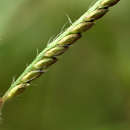Comments
provided by eFloras
Urochloa setigera can be confused with forms of U. panicoides with pubescent, paired spikelets, especially when the base is missing. Urochloa panicoides has less abruptly cuspidate spikelets, a more coarsely rugose fertile floret, and a much longer mucro on the upper lemma.
- license
- cc-by-nc-sa-3.0
- copyright
- Missouri Botanical Garden, 4344 Shaw Boulevard, St. Louis, MO, 63110 USA
Comments
provided by eFloras
In common with several other species of the genus,
Urochloa panicoides has forms with glabrous, pubescent or setosely fringed spikelets; they appear to be of no taxonomic importance.
This is an excellent fodder grass for both cattle and horses, ascending to about 1500 m,mainly in cultivated land.
- license
- cc-by-nc-sa-3.0
- copyright
- Missouri Botanical Garden, 4344 Shaw Boulevard, St. Louis, MO, 63110 USA
Description
provided by eFloras
Annual. Culms loosely tufted, geniculately ascending, 20–80 cm tall, nodes bearded. Leaf sheaths loose, with tubercle-based setae, one margin densely ciliate; leaf blades linear-lanceolate, 5–15(–20) × 0.5–1.5 cm, glabrous to thinly pilose, margins pectinate-ciliate at least toward amplexicaul base, apex acuminate; ligule 1.5–2 mm. Inflorescence axis 3–6 cm; racemes 3–10, 2–6 cm, stiff, diverging; rachis flattened, setose mainly from the short stout pedicels; spikelets usually borne singly or in pairs at base, occasionally mostly paired, overlapping by ca. 1/3 their length. Spikelets ovate-elliptic, 4–5 mm, glabrous or pubescent, cuspidate; lower glume ovate,1/4–1/3 spikelet length, 3–5-veined, obtuse; upper glume 5–9-veined with evident cross veins; upper lemma rugose, mucro 0.4–1 mm. Fl. and fr. Sep–Oct.
- license
- cc-by-nc-sa-3.0
- copyright
- Missouri Botanical Garden, 4344 Shaw Boulevard, St. Louis, MO, 63110 USA
Description
provided by eFloras
Tufted annual; culms 10-100 cm high, often ascending from prostrate rooting base. Leaf-blades linear to narrowly lanceolate, 2-15 cm long, 5-15 mm wide, subamplexicaul, coarse, glabrous or pubescent, the margins tuberculate-ciliate at least near the base. Inflorescence of 2-7 (-10 or rarely more) racemes on a common axis 1-6 cm long; racemes 1-6 cm long, bearing single or sometimes paired spikelets on a narrowly winged rhachis, the pedicels (sometimes also the rhachis) with white hairs. Spikelets elliptic, (2.5-) 3.5-4.5 (-5) mm long, acute; lower glume ovate, a quarter to almost half as long as the spikelet, very rarely more, 3-5-nerved, obtuse to subacute; upper glume often with crossveins, glabrous or pubescent lower lemma sometimes with a setose fringe; upper lemma rugulose with a mucro 0.3-1 mm long.
- license
- cc-by-nc-sa-3.0
- copyright
- Missouri Botanical Garden, 4344 Shaw Boulevard, St. Louis, MO, 63110 USA
Distribution
provided by eFloras
Distribution: Pakistan (Punjab, N.W.F.P. & Kashmir); Sudan to Yemen and south-wards to South Africa: India; introduced to Australia.
- license
- cc-by-nc-sa-3.0
- copyright
- Missouri Botanical Garden, 4344 Shaw Boulevard, St. Louis, MO, 63110 USA
Habitat & Distribution
provided by eFloras
Moist grasslands, lakesides. Sichuan, Yunnan [Bhutan, India; E and S Africa].
- license
- cc-by-nc-sa-3.0
- copyright
- Missouri Botanical Garden, 4344 Shaw Boulevard, St. Louis, MO, 63110 USA
Synonym
provided by eFloras
Panicum panicoides (P. Beauvois) Hitchcock; Urochloa jinshaicola B. S. Sun & Z. H. Hu; U. longifolia B. S. Sun & Z. H. Hu; U. longifolia var. yuanmuensis (B. S. Sun & Z. H. Hu) S. L. Chen & Y. X. Jin; U. yuanmuensis B. S. Sun & Z. H. Hu.
- license
- cc-by-nc-sa-3.0
- copyright
- Missouri Botanical Garden, 4344 Shaw Boulevard, St. Louis, MO, 63110 USA
Physical Description
provided by USDA PLANTS text
Annuals, Terrestrial, not aquatic, Stems nodes swollen or brittle, Stems erect or ascending, Stems geniculate, decumbent, or lax, sometimes rooting at nodes, Stems caespitose, tufted, or clustered, Stems terete, round in cross section, or polygonal, Stem nodes bearded or hairy, Stem internodes hollow, Stems with inflorescence less than 1 m tall, Stems, culms, or scapes exceeding basal leaves, Leaves mostly cauline, Leaves conspicuously 2-ranked, distichous, Leaves sheathing at base, Leaf sheath mostly open, or loose, Leaf sheath hairy, hispid or prickly, Leaf sheath and blade differentiated, Leaf blades linear, Leaf blades lanceolate, Leaf blades 2-10 mm wide, Leaf blades 1-2 cm wide, Leaf blades mostly flat, Leaf blades mostly glabrous, Leaf blades more or less hairy, Ligule present, Ligule a fringed, ciliate, or lobed membrane, Ligule a fringe of hairs, Inflorescence terminal, Inflorescence solitary, with 1 spike, fascicle, glomerule , head, or cluster per stem or culm, Inflorescence a panicle with narrowly racemose or spicate branches, Inflorescence with 2-10 branches, Inflorescence branches 1-sided, Rachis dilated, flat, central axis to which spikelets are attached, Flowers bisexual, Spikelets pedicellate, Spikelets sessile or subsessile, Spikelets dorsally compressed or terete, Spikelet less than 3 mm wide, Spikelets with 1 fertile floret, Spikelets with 2 florets, Spikelet with 1 fertile floret and 1-2 sterile florets, Spikelets solitary at rachis nodes, Spikelets all alike and fertille, Spikelets bisexual, Spikelets disarticulating below the glumes, Spikelets secund, in rows on one side of rachis, Rachilla or pedicel glabrous, Glumes present, empty bracts, Glumes 2 clearly present, Glumes distinctly unequal, Glumes equal to or longer than adjacent lemma, Glumes 3 nerved, Glumes 4-7 nerved, Glumes 8-15 nerved, Lemma coriaceous, firmer or thicker in texture than the glumes, Lemma 5-7 nerved, Lemma gla brous, Lemma apex truncate, rounded, or obtuse, Lemma awnless, Lemma mucronate, very shortly beaked or awned, less than 1-2 mm, Lemma straight, Palea present, well developed, Palea longer than lemma, Stamens 3, Styles 2-fid, deeply 2-branched, Stigmas 2, Fruit - caryopsis.

